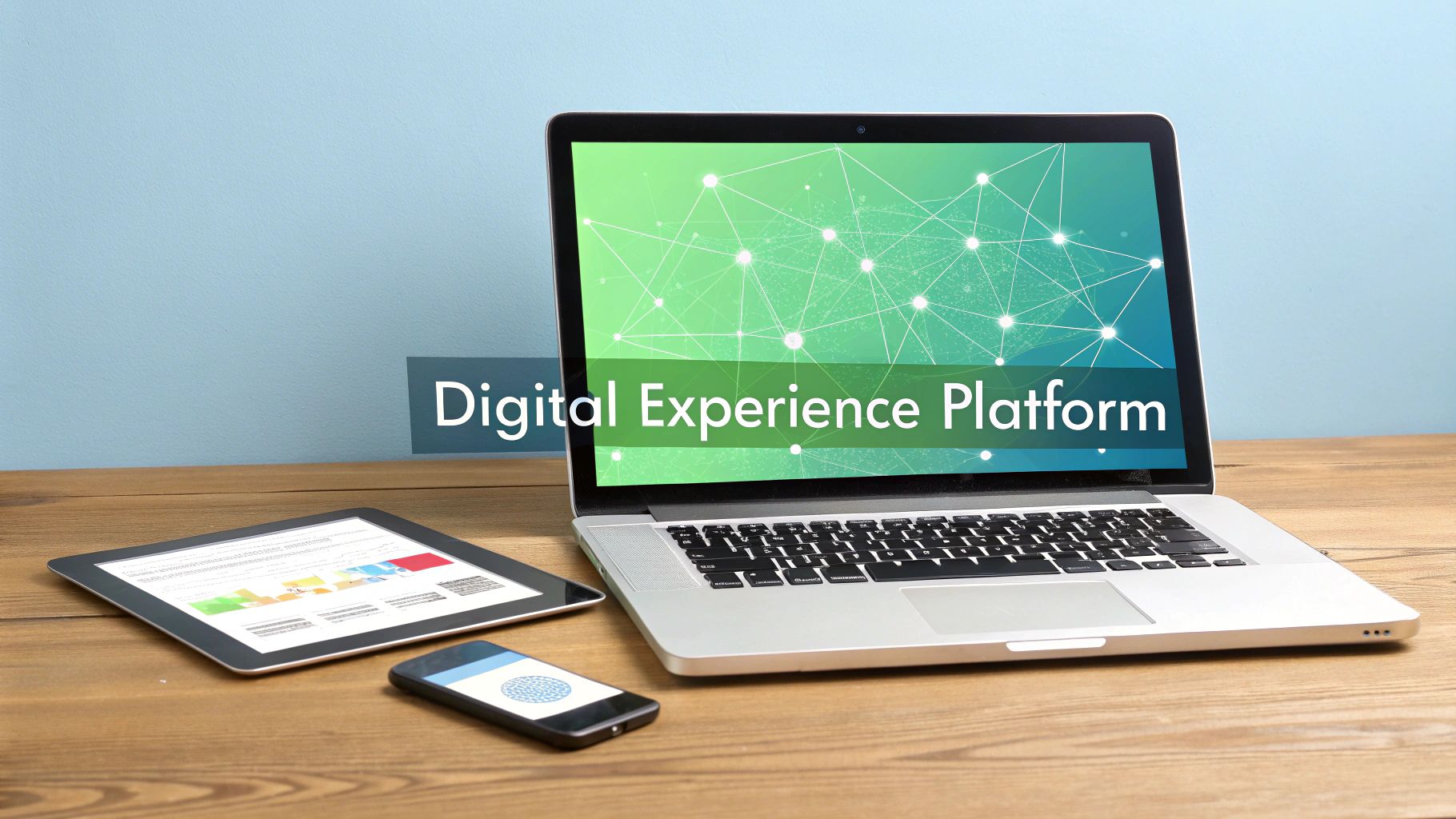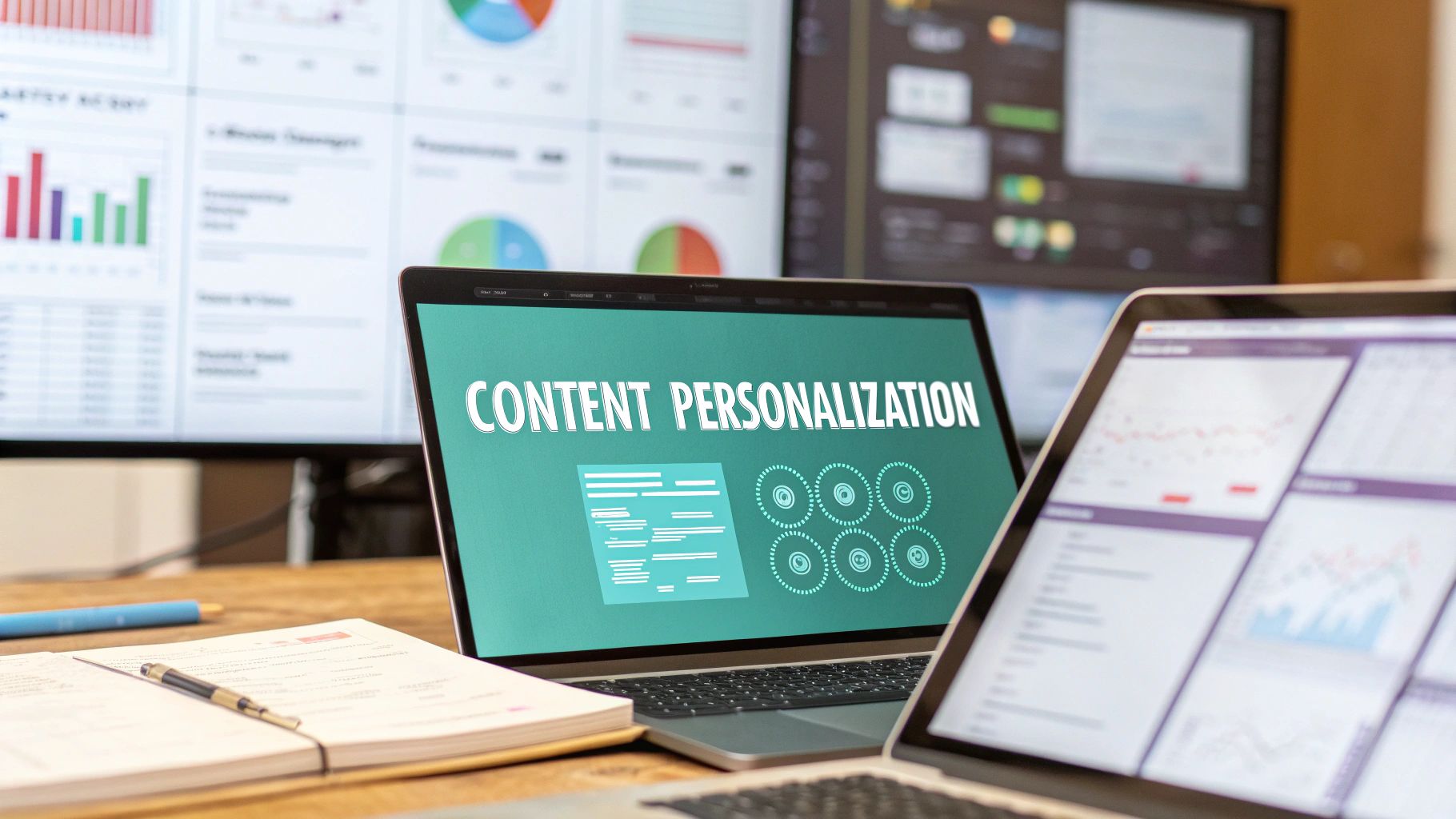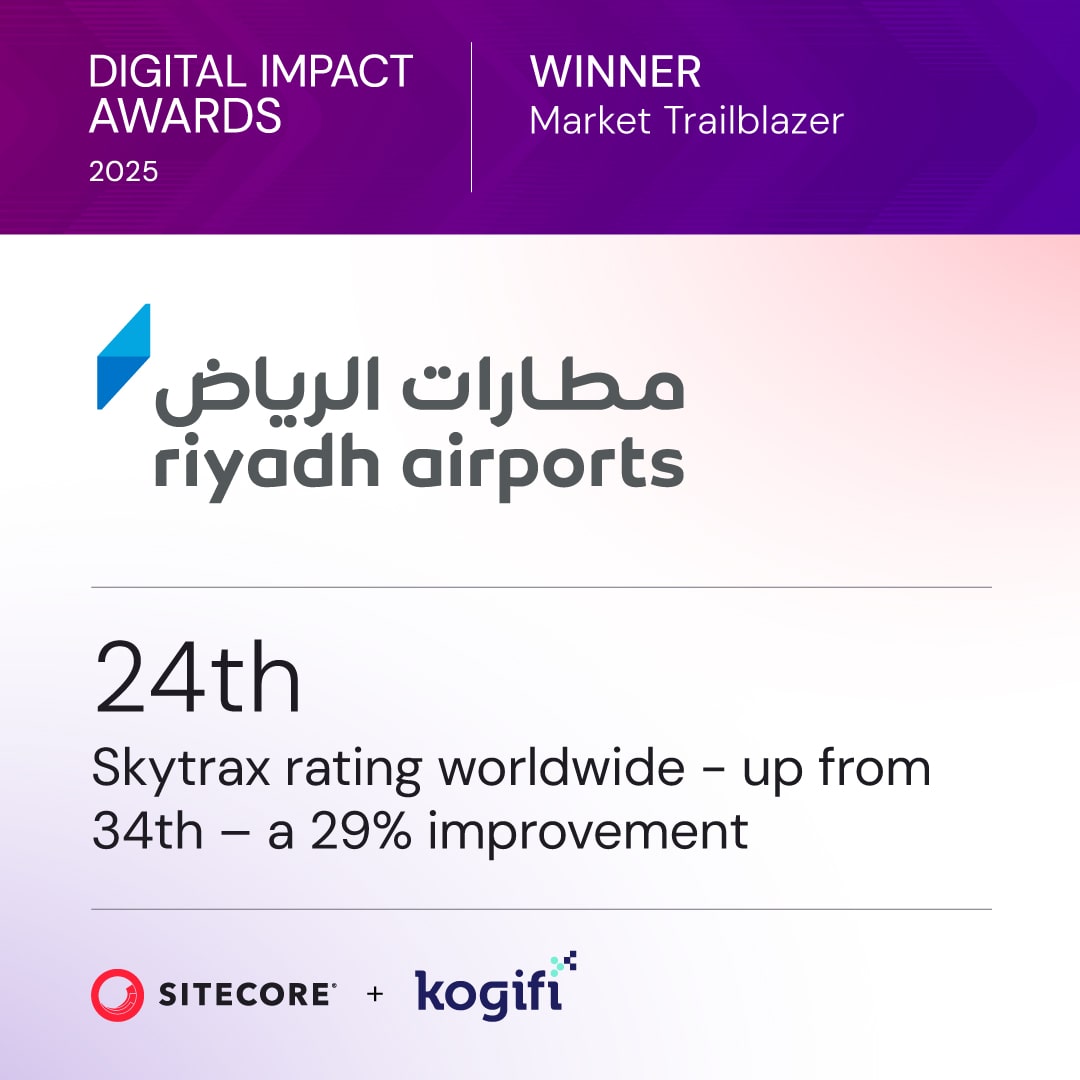A Digital Experience Platform, or DXP, is a suite of integrated software that brings your entire digital customer journey under one roof. Think of it as the command center for your digital presence. It connects your website, mobile apps, social media, and every other touchpoint into a single, cohesive ecosystem.
So, What Exactly Is a Digital Experience Platform?
Let's use an analogy. Imagine your business is a custom-built smart home. A traditional Content Management System (CMS) is like the dimmer switch for the living room lights. It does one job, and it does it well, but only in that specific room.
A DXP, on the other hand, is the central hub controlling everything—the lights, thermostat, security system, and speakers. It knows who's in the house, understands their preferences, and orchestrates all the devices to create a perfectly personalized environment. That’s precisely what a DXP, particularly a platform like Sitecore, does for your customers' digital interactions.
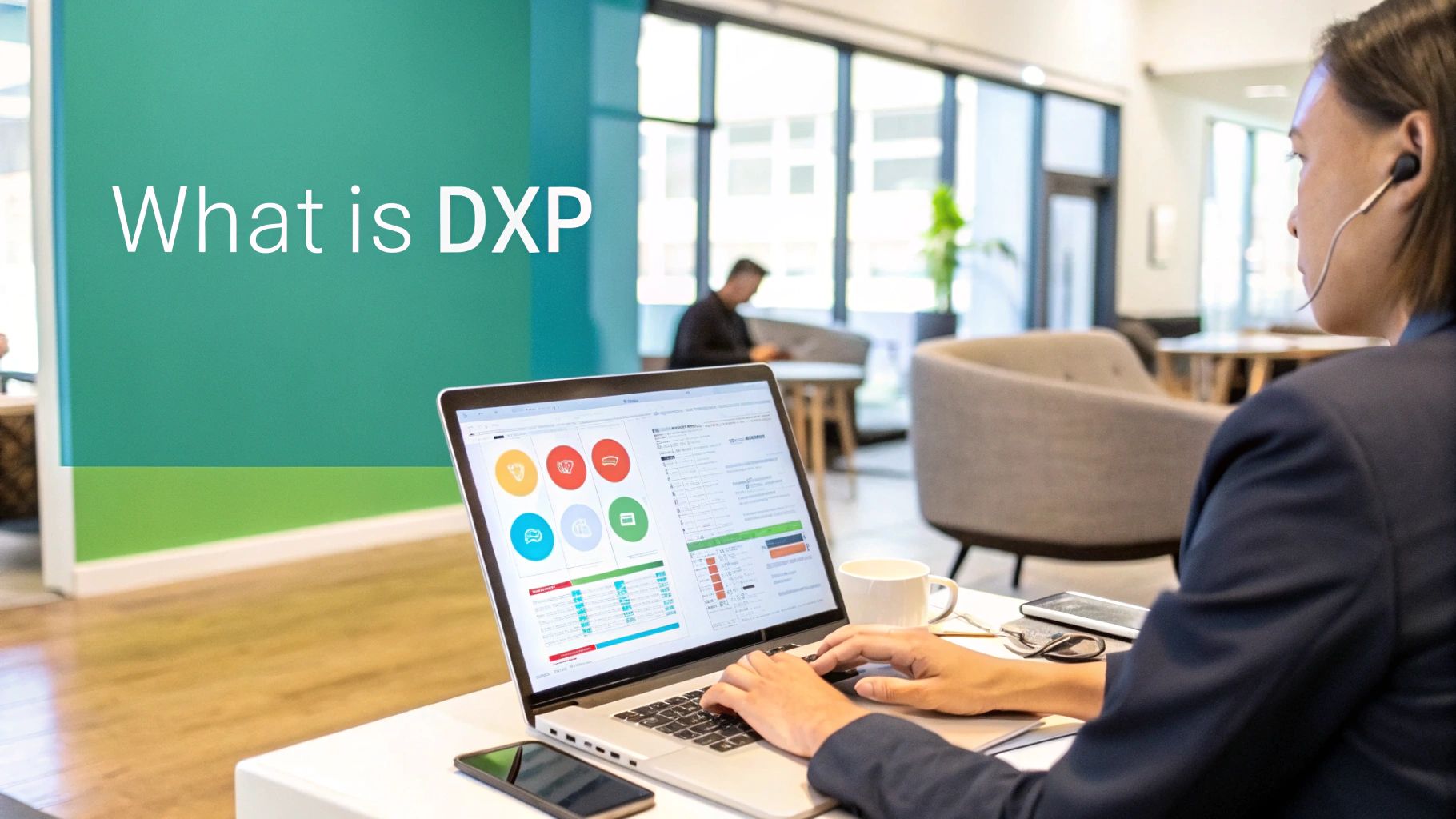
This kind of integrated approach isn't a luxury anymore; it's a fundamental business requirement. A modern DXP gives businesses the power to deliver a truly unified and personal omnichannel communication strategy across all those different touchpoints. The real goal is to move past simply managing content and start orchestrating meaningful, data-driven experiences that build real, lasting customer relationships.
This table breaks down the core differences between a DXP and a more traditional CMS.
DXP vs. Traditional CMS At a Glance
As you can see, while a CMS is focused on content, a DXP is squarely focused on the customer and their experience. It’s a strategic shift from publishing pages to building relationships.
The Rise of Composable DXPs
The most significant evolution in this space is the move toward the composable DXP. Instead of being locked into a single, rigid, all-in-one suite, a composable architecture lets you pick and choose best-in-class tools for each job. This philosophy is championed by leaders like Sitecore. It's a "plug-and-play" approach that offers incredible flexibility.
For example, you might use Sitecore XM Cloud for your core content delivery, integrate a separate platform for advanced analytics, and plug in another solution for e-commerce. All these independent services communicate seamlessly through APIs to form your customized DXP.
This modularity is a game-changer. It means your technology can grow and change right alongside your business needs. You're never stuck with a single vendor's limitations, giving you the freedom to innovate without having to rip and replace your entire system.
Where Does SharePoint Fit In?
While it’s not a customer-facing DXP on its own, a platform like Microsoft SharePoint can play a critical supporting role, especially within a composable setup. SharePoint is a powerhouse for internal collaboration and document management.
In a DXP ecosystem, SharePoint can act as a "headless" content repository for internal data, employee knowledge bases, or partner portals. This content can then be pulled via APIs and delivered through your main customer-facing platform like Sitecore, creating a consistent experience for both internal teams and external audiences.
The core idea behind a DXP is to break down silos. It connects customer-facing marketing tools with internal content systems to ensure every single interaction is consistent, informed, and impactful—no matter the channel.
The market certainly reflects this growing demand. Global digital transformation efforts are fueling robust growth, with the DXP market projected to reach $32.4 billion by 2030, expanding at a compound annual growth rate (CAGR) of 12.3%. This rapid expansion is driven by organizations in retail, healthcare, and finance who are adopting DXPs to finally unify their customer data and deliver the seamless experiences that people now expect.
What Can a Sitecore DXP Actually Do?
Let's get practical. To really wrap our heads around what a digital experience platform does, we need to look under the hood. The Sitecore ecosystem is a premier example of how these different tools come together to manage every step of a customer's journey.
Think of it this way: a DXP isn't one monolithic thing. It’s a set of specialized tools that talk to each other. When they work in concert, they create something far more powerful than the sum of their parts. That’s the whole idea behind Sitecore's modern, composable DXP.
Omnichannel Content Delivery with Sitecore XM Cloud
At its core, a DXP has to be brilliant at managing and delivering content. Sitecore XM Cloud is the next generation of the classic CMS, rebuilt for the cloud. It’s built on a "headless" architecture, which simply means the content (the "body") is separate from the presentation layer (the "head").
Why does that matter? It's a game-changer. This separation lets you create a piece of content just once and then push it out everywhere—your website, a mobile app, a digital kiosk, you name it. Your marketing team gets to build and see what they're creating visually, while developers get the freedom to work with the latest tech to build the front-end experience.
Building a Single, Cohesive View of the Customer
Great content is just the start. You have to get it to the right person at the right moment. This is where customer data comes in, and Sitecore has a powerful one-two punch for this:
Sitecore Customer Data Platform (CDP): This is the central nervous system for all your customer data. It pulls in information from everywhere—website clicks, app usage, CRM notes, in-store purchases—and stitches it all together into a single, unified profile for every single customer. It finally breaks down those frustrating data silos, giving you a genuine 360-degree view of who your customers are and what they do.
Sitecore Personalize: Once the CDP has built that rich profile, Sitecore Personalize puts the data to work. It uses smart decisioning and A/B testing to figure out the best next move for each visitor in real time. That could mean showing a personalized discount, suggesting a relevant article, or sending a perfectly timed email.
These two tools work hand-in-hand to turn anonymous website traffic into known individuals. Suddenly, you can create hyper-relevant interactions that make customers feel understood. For example, a customer browses a jacket on their phone during their commute. Later that evening, they open their laptop, and your website greets them with a banner for that very same jacket. That’s the Sitecore DXP in action.
A DXP’s real magic lies in its ability to fuse scattered data points into a single, actionable customer profile. It’s what turns raw data into intelligent, automated experiences.
Smarter Search and Centralized Assets
A great experience also means helping people find what they’re looking for without a struggle. Sitecore Search is an AI-powered tool that does more than just match keywords. It actually tries to understand what a user is looking for, delivering predictive and relevant results that make content discovery feel effortless. This is huge for keeping people on your site and preventing them from bouncing away in frustration.
Behind all of this is Sitecore Content Hub, the command center for all your brand's digital assets. It’s where your images, videos, product specs (PIM), and marketing materials all live. By keeping everything in one place, you ensure brand consistency everywhere and make life much easier for your content and marketing teams.
Connecting to SharePoint and the Internal World
While Sitecore is busy orchestrating the external customer experience, tools like SharePoint are often running the show internally. In a modern, composable DXP, SharePoint can be a critical content source. Think of internal knowledge bases, partner portals, or deep technical documentation.
Through APIs, this internal content can be pulled directly into the customer-facing experience. This ensures that everyone—from your customers to your support agents—is looking at the same information. It’s how you build a truly seamless experience, from the inside out.
How a DXP Drives Real Business Growth
Implementing a digital experience platform isn't just a technical upgrade—it's a strategic move that directly fuels measurable growth. The real magic of a DXP is its ability to turn complex features into tangible, bottom-line results like more revenue, better efficiency, and customers who stick around.

The journey starts by breaking down one of the biggest roadblocks to growth: internal data silos. When your marketing, sales, and service data are all locked away in separate systems, you can never see the full customer story. This is where a tool like the Sitecore Customer Data Platform (CDP) becomes the heart of your strategy. It acts as a central nervous system, pulling in data from every single touchpoint—website visits, app usage, CRM notes, even in-store purchases—to build one unified profile for every customer.
This true 360-degree customer view is the bedrock for creating authentic connections.
From Unified Data to Hyper-Personalization
Once you have that complete customer profile, you can finally move past generic marketing and start practicing hyper-personalization. A DXP like Sitecore uses this unified data to predict what customers need and serve up the right content, offers, and recommendations at just the right moment.
Think about a retail example: a customer adds an item to their cart on your website but doesn't check out. Instead of a generic "You left something behind!" email, the DXP can trigger a personalized message on their favorite social media app, maybe even showing a related product they looked at last week. This kind of targeted relevance makes a huge difference in engagement and, ultimately, sales.
A great DXP strategy turns customer data from a static library of information into an active engine for growth. It’s the difference between shouting at your audience and having a meaningful conversation with each person.
This thoughtful approach to personalization has a direct impact on key business metrics:
- Increased Customer Lifetime Value (CLV): When you consistently deliver relevant experiences, you build loyalty and keep people coming back for more.
- Higher Conversion Rates: Smooth, optimized journeys guide customers from discovery to purchase without the usual friction, making it easier for them to say "yes."
- Improved Customer Retention: Customers who feel understood are much less likely to jump ship to a competitor.
Boosting Operational Efficiency and ROI
Beyond the customer-facing wins, a DXP delivers major operational advantages. By centralizing your marketing tech, you can get rid of redundant tools and simplify your team's workflows. You can even integrate a platform like SharePoint to act as a headless content source for internal knowledge. This ensures your customer service teams have the exact same up-to-date information as your website, creating consistency for everyone.
Of course, having solid support strategies for successful digital experience platforms is crucial for keeping things running smoothly and getting the most out of your investment over time.
DXPs give companies the power to manage customer interactions in real time, whether that's automating responses or providing tailored feedback based on their behavior. By combining technologies like Web Experience Management (WEM) and content management systems (CMS), businesses can deliver seamless, personal experiences across all their digital channels. This integration helps orchestrate a true omnichannel strategy and modernizes old business processes to be far more efficient and engaging.
At the end of the day, every feature inside a DXP is built to connect to a strategic business goal. By unifying data, personalizing customer journeys, and optimizing operations, you build a powerful system that doesn't just make customers happier—it drives sustainable, long-term revenue growth.
Choosing Your DXP Architecture: Monolithic vs. Composable
When you’re ready to invest in a digital experience platform, one of the first big decisions you'll face is about architecture. This isn't just a technical detail—it's a choice that will fundamentally define how flexible, scalable, and future-ready your digital strategy can be. The two main paths are monolithic and composable, and they represent completely different philosophies for building customer experiences.
Let's break them down.
The Monolithic Model: The All-in-One Suite
Think of a monolithic DXP as an all-inclusive resort. Everything you need is bundled together by a single vendor in one tightly integrated package. Your content management, analytics, personalization, and e-commerce tools are all under one roof. It’s designed to be a comprehensive, works-out-of-the-box solution.
This approach definitely has its perks, especially simplicity. With one vendor, you have a single point of contact for support and a consistent user interface across all tools. This can make the initial setup and team training feel much less intimidating because everything is pre-connected.
However, that convenience can come at a cost. You're effectively locked into that one vendor's ecosystem. This can make it tough to bring in new, innovative technologies or swap out a part of the platform that's not quite cutting it anymore. Customizing or scaling individual features can also become a slow, expensive headache because you're working within the confines of a rigid structure.
The Composable Advantage: Agility and Freedom
On the other side, you have the composable DXP. Instead of an all-inclusive resort, this is like building a custom home with a team of specialist contractors. You pick and choose the absolute best tools for each specific job—maybe you love Sitecore for content, a different vendor for search, and another for commerce—and then connect them all seamlessly using APIs. This is the modern, API-first model that defines Sitecore's strategy today.
This approach hands you the keys to build a DXP that fits your exact needs, rather than trying to cram your business into a one-size-fits-all box.
This image helps visualize the decision-making process based on your company's needs and complexity.
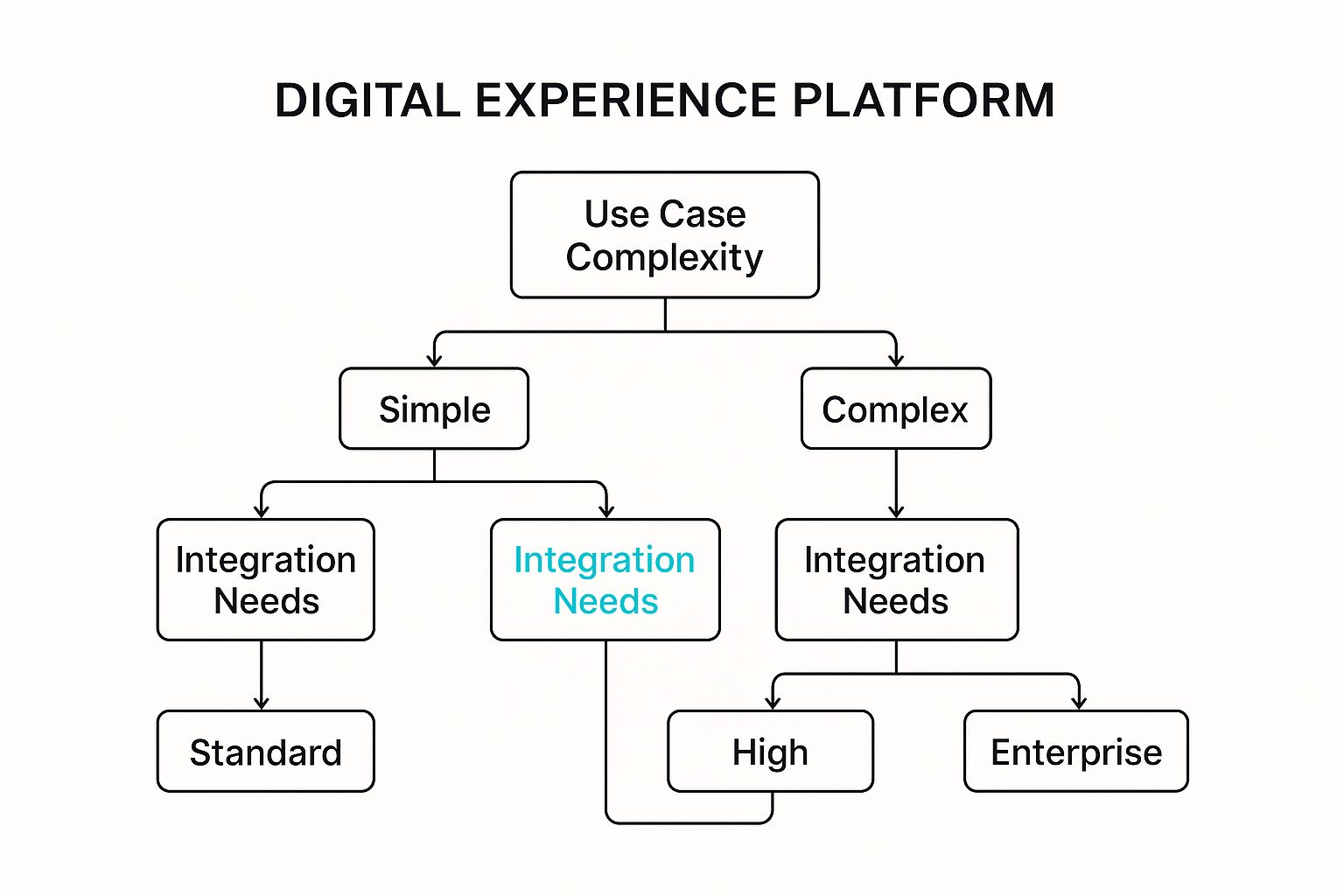
As the diagram shows, the more complex your business requirements and the more integrations you need, the more a flexible, enterprise-ready solution makes sense.
With a composable DXP, you can:
- Pick the Best Tools for the Job: You get to integrate the most powerful solutions on the market for every single capability. No more settling for a mediocre module just because it came with the package.
- Scale with Surgical Precision: Need to upgrade your search function? Just swap out that one component without having to rip out your entire system. This makes your whole platform much more responsive to market shifts.
- Innovate Faster: Your developers get to work with modern, API-first technologies, which speeds up development and opens the door to creating truly unique digital experiences.
This strategy is absolutely critical for any business that wants to build a digital foundation that is both resilient and adaptable. If you want to dive deeper into this model, check out our guide on future-proofing with composable DXP architecture.
Comparing Monolithic and Composable DXP Architectures
To make the choice clearer, here’s a side-by-side look at how these two architectural models stack up against each other. This table breaks down the key differences to help you think through which approach aligns best with your team's capabilities and long-term business goals.
Ultimately, the best choice depends entirely on your specific context. A monolithic platform might be a great starting point for some, but a composable architecture offers the competitive edge for those looking to lead.
Where Does SharePoint Fit In?
Even tools you might think of as purely for internal use, like SharePoint, have a powerful role to play in a composable world. SharePoint can act as a fantastic headless content source for things like employee portals, internal knowledge bases, or document libraries that need to be accessed externally.
By connecting SharePoint to a customer-facing DXP like Sitecore through APIs, businesses can seamlessly surface internal content to external audiences. This breaks down information silos and helps create a more unified experience for both customers and employees.
So, how do you choose? The right answer depends on your organization's digital maturity, technical resources, and strategic ambitions. A monolithic DXP can be a solid choice for companies with straightforward needs who prefer a single-vendor relationship. But for any organization with its eyes on market leadership, the agility and future-readiness of a composable DXP offer a decisive advantage.
How AI Is Reshaping the Modern DXP
Artificial intelligence isn't just a shiny new feature anymore; it's quickly becoming the engine at the heart of the most effective Digital Experience Platforms. Thanks to AI and machine learning, DXPs are evolving from passive content libraries into smart systems that can actually anticipate what your customers want and deliver it instantly.

This isn't just about simple automation. It's about using mountains of data to make split-second, intelligent decisions throughout the entire customer journey. A modern DXP can now figure out which piece of content a specific visitor needs to see next—and serve it up before they even know to look for it.
The Power of Predictive Personalization
A platform like Sitecore is a perfect example of this in action. Its DXP has moved far beyond basic personalization rules, like showing different content based on a user's city. Instead, Sitecore uses AI to deliver predictive personalization, which means it analyzes countless data points from user behavior to guess what they'll do next and automatically shape the experience to match.
Think about it: a visitor clicks on a few product pages on your website. The AI engine can instantly tag them as part of a "high-intent researcher" group—a segment you might not have even known existed. The DXP then dynamically rearranges the page to highlight detailed case studies and whitepapers. This happens on the fly, without a marketer ever having to set up a rule for that specific situation.
A DXP powered by AI doesn't just react to what customers do; it anticipates what they are about to do. It’s the difference between following a map and having a GPS that reroutes you around traffic before you even see the brake lights.
This ability fundamentally changes how you can engage with your audience. It makes a level of relevance possible that was simply out of reach before, turning every interaction into a genuine one-to-one conversation, even at massive scale.
Generative AI and Smarter Content Creation
Generative AI is another huge piece of the puzzle, especially when it comes to creating content. This technology is becoming an indispensable assistant for marketing teams, helping them work faster and smarter.
Here’s how it fits within a DXP:
- Suggest Content Variations: Instantly generate a dozen different headlines or call-to-action buttons for A/B testing.
- Summarize Complex Information: Turn a long-form blog post into a few punchy social media updates or a concise email summary.
- Automate Image Tagging: Help wrangle massive digital asset libraries, making content much easier for your team to find and use again later.
Of course, generative AI won’t replace human creativity, but it does eliminate a ton of the grunt work. This frees up your team to focus on bigger-picture strategy and high-impact creative ideas. Diving into the AI in DXPs benefits vs challenges can help you figure out how to best use these powerful tools.
Today's best DXPs are built on cloud-native foundations, weaving together core features like content management with these advanced AI capabilities. This blend is what allows companies to create seamless omnichannel experiences that adapt in real time to what each individual customer is doing.
Common Questions About Digital Experience Platforms
As you dig into the world of digital experience platforms, a few key questions always pop up. It's easy to get lost in the jargon, but understanding the real-world differences between these technologies is what will help you make the right call for your business. Let's clear up some of the most common points of confusion, especially when it comes to enterprise-grade tools like Sitecore and how platforms like SharePoint fit into the picture.
What Is the Main Difference Between a DXP and a CMS?
Think of a Content Management System (CMS) as a digital filing cabinet. Its main job is to help you create, manage, and publish content for a single destination—usually, your website. It's fantastic at what it does, but its focus is narrow.
A Digital Experience Platform (DXP) is something else entirely. It’s more like a central command center for your entire customer relationship. It includes CMS functionality, of course, but it wraps it with other critical tools. We're talking about things like a Customer Data Platform (CDP) to create a single view of each user, powerful personalization engines to tailor experiences, and deep analytics to understand what’s actually working.
Simply put: a CMS manages content. A DXP manages the customer's entire experience with your brand, no matter which channel they're on.
How Does Sitecore Lead in the DXP Market?
Sitecore has earned its reputation as a leader in the DXP space for a couple of big reasons: its obsession with deep personalization and its early, wholehearted embrace of a composable architecture. Instead of locking you into a rigid, one-size-fits-all platform, Sitecore gives you a flexible set of best-in-class products that you can assemble into a DXP that perfectly fits your business.
This powerful toolkit includes:
- Sitecore XM Cloud: A modern, cloud-native CMS that lets marketers create content once and deliver it anywhere, without headaches.
- Sitecore CDP & Personalize: This duo works together to build unified customer profiles from all your data sources and then uses that insight to deliver one-to-one personalized experiences in real time.
- Sitecore Content Hub: This is your single source of truth for every digital asset—from images to product specs—ensuring brand consistency and making content operations much smoother.
This composable approach means you can start with what you need today and add more capabilities as you grow. It’s a smarter, more flexible way to build your tech stack that won't become obsolete in a few years. For a wider view, it's helpful to see an overview of what are the best digital experience platforms to understand how different vendors stack up.
Can SharePoint Function as a DXP?
On its own, no—SharePoint is not a DXP. It’s a powerhouse for internal collaboration, document management, and building company intranets. But it simply wasn't built for the core tasks of a DXP, like orchestrating omnichannel customer journeys or sophisticated personalization.
However, SharePoint becomes incredibly valuable when it’s integrated into a composable DXP ecosystem. It can act as a "headless" content repository for internal knowledge bases, partner portals, or massive documentation libraries that need to be shared externally.
A DXP like Sitecore can then connect to SharePoint via APIs, pull that content, and deliver it to your customer-facing channels. This way, your internal teams and your external customers are both drawing from the same well of information, creating a truly unified digital experience.
This integration strategy transforms SharePoint from a purely internal tool into a key piece of your customer experience puzzle. It’s a perfect example of using composable architecture to get the best out of every tool you have.
Is a DXP Only for Large Enterprise Companies?
That used to be the case. In the past, DXPs were monolithic giants that required a massive upfront investment, putting them out of reach for all but the largest enterprises.
Today, the game has completely changed, thanks to composable and cloud-native (SaaS) models. Sitecore's approach completely flips the old script. It lets businesses adopt DXP capabilities piece by piece, following a "start smart and scale" strategy. You could begin with a headless CMS like Sitecore XM Cloud and then, as your needs mature, add on advanced tools for personalization or customer data management.
This modular path forward removes the huge initial cost and complexity, making DXP technology a realistic and strategic investment for any company serious about delivering personalized, data-driven customer experiences. It's a much more democratic way to access the tools you need to compete.
At Kogifi, we specialize in designing and implementing powerful Digital Experience Platforms using Sitecore and SharePoint to drive real business results. If you're ready to transform your customer journey, we can help. https://www.kogifi.com

















